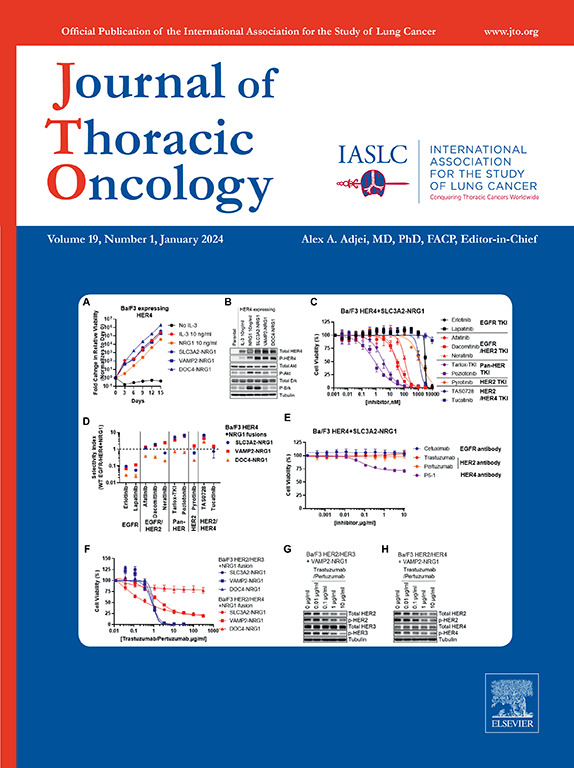Risk Factors for Locoregional Relapse After Segmentectomy: Supplementary Analysis of the JCOG0802/WJOG4607L Trial
IF 21
1区 医学
Q1 ONCOLOGY
引用次数: 0
Abstract
Introduction
The JCOG0802/WJOG4607L trial revealed superior overall survival in segmentectomy compared with lobectomy for small-peripheral NSCLC. Nevertheless, locoregional relapse (LR) is a major issue for segmentectomy. An ad hoc supplementary analysis aimed to determine the risk factors for LR and the degree of advantages of segmentectomy on the basis of primary tumor sites.
Methods
Participants in multi-institutional and intergroup, open-label, phase 3 randomized controlled trial in Japan were enrolled from August 10, 2009, to October 21, 2014. Risk factors for LR after segmentectomy and clinical features following the primary tumor site were investigated.
Results
Of 1105 patients, 576 and 529 underwent lobectomy and segmentectomy, respectively. The primary tumor site for segmentectomy was the left upper division, left lingular segment, left S6, left basal segment, right upper lobe, right S6, or right basal segment. Multivariable analysis in the segmentectomy group revealed that pure-solid appearance on thin-section computed tomography (OR = 3.230; 95% confidence interval [CI]: 1.559–6.690; p = 0.0016), margin distance less than the tumor size (OR = 2.682; 95% CI: 1.350–5.331; p = 0.0049), and male sex (OR = 2.089; 95% CI: 1.047–4.169; p = 0.0366) were significantly associated with LR. Patients with left lingular segment tumors (OR = 4.815; 95% CI: 1.580–14.672) tended to experience LR more frequently than those with left upper division tumors, although primary tumor sites were not statistically significant.
Conclusions
Thin-section computed tomography findings and margin distance are important factors to avoid LR in segmentectomy.

分段切除术后局部复发的风险因素:JCOG0802/WJOG4607L 试验的补充分析。
导言:JCOG0802/WJOG4607L试验显示,小周围非小细胞肺癌分段切除术的总生存率优于肺叶切除术。然而,局部区域复发(LR)是分段切除术的一个主要问题。一项特别补充分析旨在根据原发肿瘤部位确定LR的风险因素和分段切除术的优势程度:方法:2009年8月10日至2014年10月21日,日本多机构、跨组、开放标签、3期随机对照试验的参与者被纳入其中。结果:在1105名患者中,576名患者和576名患者的LR发生率分别为0.9%和0.9%:结果:在 1105 名患者中,分别有 576 人和 529 人接受了肺叶切除术和肺段切除术。分段切除术的原发肿瘤部位为左上叶、左舌段、左 S6、左基底段、右上叶、右 S6 或右基底段。分段切除组的多变量分析显示,薄层计算机断层扫描显示的纯实性外观(几率比3.230;95%保密区间[CI] 1.559-6.690;P = 0.0016)、边缘距离小于肿瘤大小(几率比2.682;95% CI 1.350-5.331;P = 0.0049)和男性性别(几率比:2.089;95% CI:1.047-4.169;P = 0.0366)与LR显著相关。左侧舌状节段肿瘤患者(几率比4.815;95% CI 1.580-14.672)往往比左侧上段肿瘤患者更常出现LR,尽管原发肿瘤部位没有统计学意义:结论:薄层计算机断层扫描结果和边缘距离是避免分段切除术中出现LR的重要因素。
本文章由计算机程序翻译,如有差异,请以英文原文为准。
求助全文
约1分钟内获得全文
求助全文
来源期刊

Journal of Thoracic Oncology
医学-呼吸系统
CiteScore
36.00
自引率
3.90%
发文量
1406
审稿时长
13 days
期刊介绍:
Journal of Thoracic Oncology (JTO), the official journal of the International Association for the Study of Lung Cancer,is the primary educational and informational publication for topics relevant to the prevention, detection, diagnosis, and treatment of all thoracic malignancies.The readship includes epidemiologists, medical oncologists, radiation oncologists, thoracic surgeons, pulmonologists, radiologists, pathologists, nuclear medicine physicians, and research scientists with a special interest in thoracic oncology.
 求助内容:
求助内容: 应助结果提醒方式:
应助结果提醒方式:


